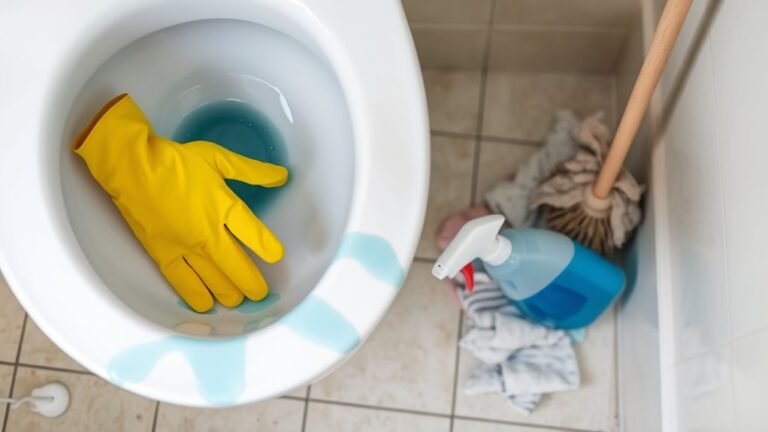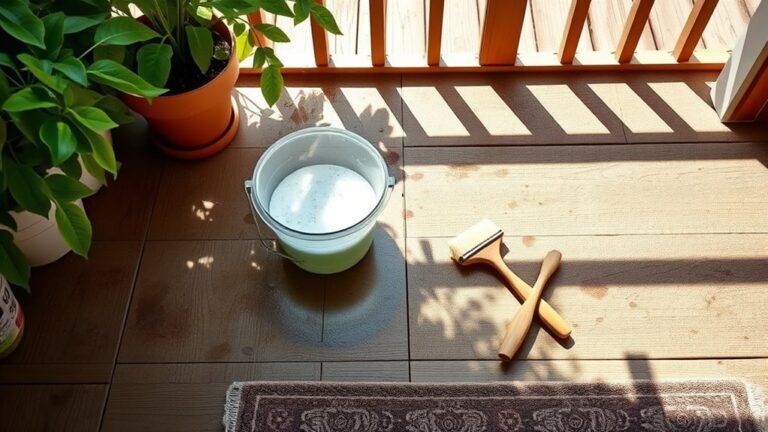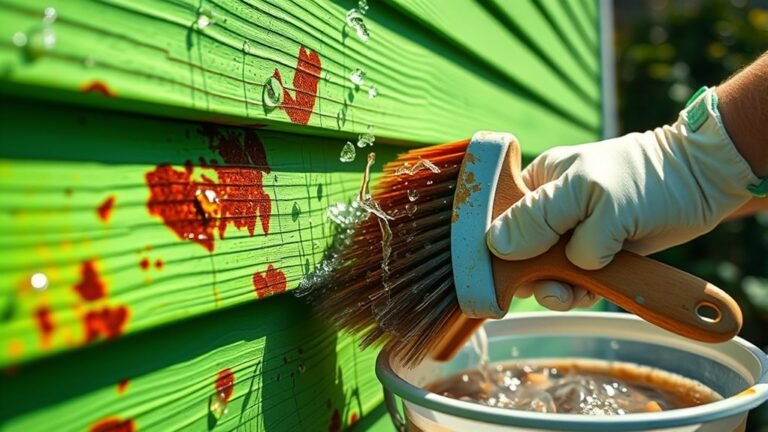How to Clean Blanket Upholstery
To clean blanket upholstery, first check its fabric type on the tag to choose the right method—wool needs gentle cold-water care, synthetics tolerate stronger cleaning. Gather soft brushes, microfiber cloths, a vacuum with upholstery tools, and a mild, pH-neutral detergent. Vacuum to remove dust and pet hair, then treat stains carefully by blotting with the appropriate cleaner. Air dry away from heat to prevent damage and freshen fibers with baking soda. Keep going to uncover effective stain treatments and maintenance tips.
Assessing the Type of Blanket Fabric

Before you begin cleaning your blanket upholstery, it is crucial to identify the fabric type, as different materials require specific care methods. You’ll want to examine the fabric types carefully—common options include wool, cotton, synthetic blends, or delicate fibers like silk. Each demands tailored cleaning methods to avoid damage. For instance, wool often needs gentle, cold water cleaning, while synthetics tolerate more robust approaches. Check manufacturer tags or test a small, hidden area with your chosen cleaner to gauge fabric reaction. By understanding the specific fabric type, you can select the safest and most effective cleaning methods, preserving your blanket’s texture and color. This assessment empowers you to clean confidently and maintain your upholstery’s freedom to look fresh and last longer without risking harm. It is also important to choose gentle, biodegradable detergents that are free from harsh chemicals to protect delicate fibers during cleaning.
Preparing Your Cleaning Tools and Materials
Gathering the right cleaning tools and materials is essential for effectively rejuvenating your blanket upholstery without causing damage. Start by gathering supplies such as a soft-bristle brush, microfiber cloths, a vacuum with an upholstery attachment, and a spray bottle for applying cleaners evenly. When choosing cleaners, opt for gentle, fabric-safe solutions—preferably pH-neutral or specifically designed for delicate textiles—to avoid color fading or fiber weakening. Test your cleaner on a hidden patch to verify compatibility. Avoid harsh chemicals or bleach. Additionally, having distilled water on hand helps prevent mineral residue during rinsing. Organizing these supplies within easy reach streamlines your cleaning process, giving you freedom to focus on each step carefully and confidently, guaranteeing your blanket upholstery remains pristine and comfortable without unnecessary risk. It is also important to assess the fabric type before selecting cleaning methods to protect the texture and color of your upholstery.
Removing Dust and Pet Hair From Blanket Upholstery

To effectively remove dust and pet hair from your blanket upholstery, start by using a vacuum cleaner equipped with an upholstery attachment. Employ slow, deliberate vacuum techniques, moving the nozzle against the fabric’s grain to dislodge deeply embedded particles. Focus on edges and seams, where debris tends to accumulate. For stubborn pet hair that the vacuum misses, use a lint roller, pressing firmly and rolling in one direction to lift hairs without damaging the fibers. You can also wrap tape around your hand, sticky side out, to reach tight spots. Regularly cleaning your blanket upholstery with these methods not only preserves its appearance but also enhances your living space’s air quality, giving you the freedom to enjoy a fresh, inviting environment without hassle or residue. Using eco-friendly options for cleaning upholstery can help maintain a healthy environment for both you and your pets.
Treating Common Stains on Blanket Upholstery
After you’ve removed dust and pet hair from your blanket upholstery, the next step is addressing stains that can mar its appearance. Start by identifying the stain type—whether it’s oil-based, protein, or dye-related—to select an appropriate stain removal method. For oil stains, gently blot with a dry cloth, then apply a mild detergent solution, avoiding harsh scrubbing that can damage fibers. Protein stains like food or blood respond well to cold water and enzymatic cleaners. Always test your cleaning solution on an inconspicuous area first to guarantee fabric protection. Blot, don’t rub, to prevent spreading. After treatment, use a damp cloth to remove residues. By treating stains promptly and carefully, you maintain the upholstery’s look and extend its lifespan, preserving your freedom to enjoy a fresh, inviting space. Organizing your cleaning tools beforehand ensures a more efficient and less frustrating stain removal process, similar to how tool organization aids in sofa removal.
Tips for Drying and Maintaining Freshness

Although drying blanket upholstery might seem straightforward, improper techniques can lead to lingering odors, fabric damage, or mildew growth. To maintain freshness and prolong your upholstery’s life, follow these key drying techniques and freshness tips:
- Air Dry Naturally: Place your blanket upholstery in a well-ventilated area, avoiding direct sunlight to prevent fading and fiber weakening.
- Use Fans or Dehumidifiers: Accelerate drying and reduce moisture buildup, which inhibits mildew formation.
- Avoid Heat Sources: Never use high heat or direct dryers, as they can shrink or distort the fabric.
- Freshness Maintenance: Regularly sprinkle baking soda, let it sit for 15 minutes, then vacuum to neutralize odors and refresh fibers.
- Acting quickly is important because stains begin to set within 24 to 48 hours, making prompt drying essential to prevent permanent damage.
Frequently Asked Questions
Can I Use a Steam Cleaner on Blanket Upholstery?
You can use a steam cleaner on blanket upholstery, but it depends on the blanket fabric types. Natural fibers like wool or cotton usually handle steam well, offering steam cleaner benefits like deep cleaning and sanitizing without chemicals. However, synthetic or delicate fabrics might get damaged or shrink. Always check the care label and test a small hidden spot first. That way, you keep your upholstery fresh while protecting its texture and freedom to relax.
How Often Should I Deep Clean Blanket Upholstery?
Like clockwork, your blanket upholstery needs a deep cleaning frequency of about every six to twelve months to keep it fresh and vibrant. For ideal upholstery maintenance tips, vacuum regularly, spot-clean spills immediately, and rotate cushions to prevent uneven wear. This routine not only preserves fabric integrity but also frees you from unexpected grime buildup, letting you enjoy your space with confidence and comfort, unburdened by hidden dirt or allergens.
Are Commercial Upholstery Cleaners Safe for All Blanket Fabrics?
Commercial upholstery cleaners aren’t always safe for all fabric types, especially delicate blanket fabrics. You’ve got to check the label and test a small, hidden spot first to avoid damage. Some cleaning agents contain harsh chemicals that might weaken fibers or cause discoloration. If your blanket upholstery is made from natural fibers like wool or cotton, opt for gentle, fabric-specific cleaners. Always follow manufacturer guidelines to keep your fabric looking its best without risking harm.
Can Blanket Upholstery Cause Allergies?
When it comes to blanket upholstery, you might find that it can be a double-edged sword. Allergy symptoms like sneezing, itching, or watery eyes can arise if dust mites, pet dander, or mold accumulate. To keep freedom from irritation, follow prevention tips such as regular vacuuming, using hypoallergenic covers, and ensuring good ventilation. Staying proactive helps you enjoy your space without sacrificing comfort or health.
What Is the Best Way to Store Blanket Upholstery When Not in Use?
When storing blanket upholstery, you’ll want to choose storage solutions that prioritize fabric protection. Start by cleaning the fabric thoroughly to avoid trapping dirt or moisture. Use breathable garment bags or cotton sheets to cover the upholstery—plastic can trap humidity and cause mildew. Store it in a cool, dry place away from direct sunlight to prevent fading. This way, you keep your upholstery fresh and ready to use whenever freedom calls you back to comfort.






